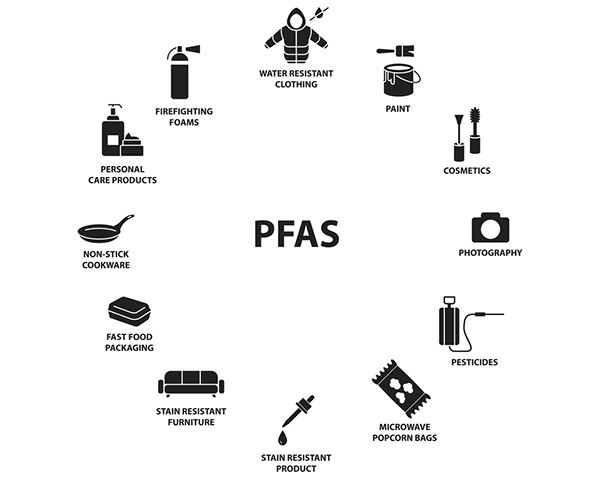
The Latest on Eliminating PFAS Chemicals
States step up to combat PFAS
Nearly all Americans are exposed to water tainted with low levels of toxic chemicals. The Legal Examiner recently stated that 97% of the US population has these chemicals in their bloodstream. Perfluoroalkyl and polyfluoroalkyl substances (PFAS) are also called “forever chemicals” because they don’t break down in the environment.
PFAS have been present in drinking water since the 1940s and a recent study found that the contamination of soil, rain, and surface water is so pervasive that it cannot be reversed without advanced or expensive technology. More than 2,800 sites in all 50 states are contaminated by PFAS.
What Are PFAS Used For?
PFAS are used for nonstick pans, waterproofing outdoor clothing, food packaging, carpeting, and firefighting foam used on military bases and commercial airports. They are also found in waterproof cosmetics, sunscreen, shampoo, and shaving cream. Waxes, paints, and stains also contain PFAS. They are literally present in abundance in everyday life.
What Are the Health Risks From PFAS?
Research has linked PFAS to a host of health problems. Kidney cancer, testicular cancer, endocrine disruption and even an increased risk of contracting infectious diseases like COVID-19 as well as reducing the effectiveness of vaccines.
The toxic contamination of water at more than 400 active and closed military bases has drawn a lot of attention due to the devastating illnesses and adverse health effects. The most infamous case involves North Carolina’s Camp Lejeune. Documented illnesses there include birth defects, infertility, miscarriages, live and kidney disorders, autoimmune diseases, cardiovascular diseases, Parkinson’s disease, Non-Hodgkin’s lymphoma, and at least nine different cancers.
What About Federal Regulation of PFAS?
When the Toxic Substances Control Act of 1976 was enacted, PFAS were not included. The Clean Water Act and the Clean Air Act of the 1970s also didn’t include PFAS. The companies who originally created them were supposed to research the potential harms of these chemicals and inform the Environmental Protection Agency (EPA) of the results. They kept the results of their research secret for decades.
The 1980 Superfund Law created a tax on petroleum and chemical industries and billions of dollars were used to clean up abandoned hazardous waste sites, but thousands of sites were not included.
In August of 2022, the EPA proposed that two commonly used PFAS should be classified as hazardous substances and there should be advisories on their presence in drinking water. If implemented, these advisories are not laws, and therefore wouldn’t carry the force of law.
What Are the States Doing About PFAS?
Rather than wait for the EPA and federal regulations to take action, many states are stepping up. They are enforcing drinking water standards, adopting PFAS guidance and notification actions, replacing PFAS in certain products with safer alternatives, and more.
- Maine and Washington state agencies have the authority to ban PFAS in many products
- Eleven states have begun removing PFAS from food packaging
- Five states are restricting PFAS in carpets, rugs and more
- California, Colorado and Maryland are eliminating PFAS from cosmetics
- Eleven states have banned the sale of firefighting foam with PFAS
- Maine became the first state to ban PFAS in all new products except those essential to health and safety that doesn’t have a PFAS-free alternative
Sixteen states have filed lawsuits against PFAS manufacturers like the 2018 lawsuit by the state of Minnesota against 3M that resulted in a settlement of $850 million. Industry advocates oppose a federal ban on PFAS and while there is ongoing disagreement among legislators on what federal regulations should be, states are taking independent action.